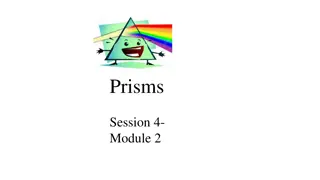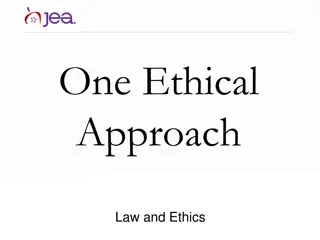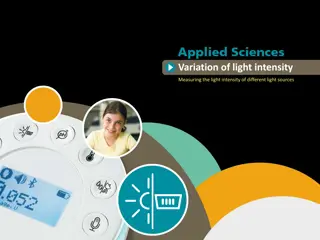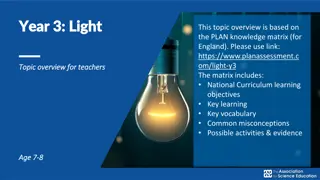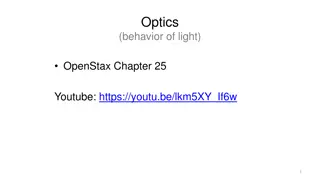
Understanding FERPA and Disability Service Professionals' Role in Student Crisis Support
Learn about the Family Educational Rights and Privacy Act (FERPA) and the responsibilities of Disability Service professionals in supporting students in crisis situations. Explore common misconceptions, objectives, and guidelines for sharing sensitive information effectively.
Download Presentation

Please find below an Image/Link to download the presentation.
The content on the website is provided AS IS for your information and personal use only. It may not be sold, licensed, or shared on other websites without obtaining consent from the author. If you encounter any issues during the download, it is possible that the publisher has removed the file from their server.
You are allowed to download the files provided on this website for personal or commercial use, subject to the condition that they are used lawfully. All files are the property of their respective owners.
The content on the website is provided AS IS for your information and personal use only. It may not be sold, licensed, or shared on other websites without obtaining consent from the author.
E N D
Presentation Transcript
Welcome to 7.8 DS Role in BIT & the FERPA 7.8 DS Role in BIT & the FERPA Myths Interfering in Supporting Myths Interfering in Supporting Students in Crisis Students in Crisis Please be respectful of your colleagues by silencing your phone. If you need to answer a call, please go to the hallway.
Conference Inclusion Statement We ask you to join us in creating a culture of Access Inclusion Civility, and Respect this week and in all aspects of our organization.
Who We Are Who We Are Maranda Maxey, MA (Appalachian State University) ADA/504 Coordinator & Director, Office of Disability Resources Early Intervention Team Consultant, Campus Awareness Response & Education (CARE), & Threat Assessment Team Consultant Chris Stone, Ed D (University of North Carolina Wilmington) Director, Disability Resource Center Student Behavioral Intervention Team (SBIT), T-IX Investigator, & Committee for Exceptional Disciplinary Emergencies (CEDE)
Overview Objectives FERPA Basics Misconceptions of FERPA Understanding BIT Rationale of DS Involvement Common DS Professional Questions re: BIT Participation Activity
Objectives for the Day Identify Disability Service (DS) professional s responsibilities within BIT, and how to employ professional judgement in determining what, when, and with whom sensitive information is shared. Articulate appropriate expectations of FERPA, and evaluate when DS involvement serves students with disability in BIT-type situations.
A Basic Understanding FERPA [Family Education Rights and Privacy Act] Protects the privacy of student education records. While generally requires permission to release, allowance exists under certain conditions or to (including): School officials with legitimate educational interest; Other schools to which a student is transferring; Comply with a judicial order or lawfully issued subpoena; Appropriate officials in cases of health and safety emergencies; and State and local authorities, within a juvenile justice system, pursuant to specific State law. www2.ed.gov/ferpa
But, FERPA! The (Mythical) Arguments Against Sharing Information It s HIPPA protected! It was given to me/us in confidence. I must protect the student from anyone knowing they have a disability.
FERPA is Not: Granted Verbally Blanket Confidentiality Intended to Limit Appropriate Conversations Our Weapon of Control Carte Blanche -- Allows one to speak with designee, but does not require it. (e.g., faculty contacted by parent)
Understanding the BIT A Behavioral Intervention Team (BIT) is a multi-disciplinary group whose purpose is to support its target audience (students, employees, faculty, staff, community, workplace) via an established protocol designed to help detect early indicators of the potential for disruptive conduct, self-harm, and the risk of violence to others. National Behavioral Intervention Team Association (NaBITA) www.nabita.org
Understanding the BIT Role of BIT Centralize reporting, triage reports, assess threat/risk, assess available resources, perform or empower interventions, coordinate follow up, assess long-term success/outcomes, educate the community (Sokolow and Lewis, 2009, p. 4). Red Flags Disturbing Patterns, Trends, Disturbances Identify, Investigate, Assess, and Monitor Recommend proactive & non-punitive approaches Help students obtain resources which may enable them to remain focused on health and achieving success while minimizing negative impacts on the student s and their peers overall academic experience.
Understanding the BIT Committee Make Up Multi-Disciplinary Generally represents Academic Affairs, Advising, Environmental Health and Safety, Student Affairs [Counseling Center, Student Health, Interpersonal Violence], University Police, & Disability Services (DS) Some more academically-focused; others student-centered
Understanding the BIT A BIT By Any Other Name Student Behavioral Intervention Team Action Crisis Team for Students (ACTS) Campus Intervention Team (CIT) Student Review Team(SRT) Communicating Action Response for Emergency (CARE) Ensuring Action for Student in Emergency (EASE) Student Protection Response Team (SPRT) Student Behavior Consultation Team (SBCT) Student Crisis Action Team (SCAT) Action for Students in Suffering Team (ASiST) Assessment and Care Team (ACT) Care and Action for Students Team (CAST) Student Wellness Team Students of Concern Committee
Why We Participate leads collaborations with students, faculty, staff, and the campus community to cultivate a universally designed environment, and facilitates the removal of existing barriers for the full inclusion of people with disabilities. interact and collaborate with faculty, staff, and students to achieve an equitable learning environment for students with disabilities to ensure that disabled students, employees and visitors, have a similar, if not identical, experience to that of their non-disabled counterparts.
Common Q? Posed by DS Providers, or Found in Listserv Archives, re: BIT
Q?: What, when, and with whom should information be shared Q?: What, when, and with whom should information be shared when the student is known by DS? when the student is known by DS?
Q?: What, when, and with whom information is shared? Q?: What, when, and with whom information is shared? Case-by-Case Consideration based on: Who are relevant officials? Is the Behavior of Concern (BoC) related to the student s disability? Is disclosure necessary to protect the health and safety of individual student or those around them?
Q?: What is the legitimate need to know rationale inherent in Q?: What is the legitimate need to know rationale inherent in FERPA when it involves DS held knowledge and information FERPA when it involves DS held knowledge and information about a student? about a student?
Q?: Legitimate need to know rationale inherent in FERPA when it Q?: Legitimate need to know rationale inherent in FERPA when it involves DS knowledge? involves DS knowledge? Relevant information used to proactively remove a disability-related barrier the student may encounter Useful in determining if behavior of concern can be mitigated by a reasonable accommodation Importance within Direct Threat Analysis
Q?: Are there advisable limits or concerns with the Q?: Are there advisable limits or concerns with the dissemination of disability dissemination of disability- -related information? related information? And, And, How might this be appropriately and systemically addressed How might this be appropriately and systemically addressed so as to protect students from unnecessary disclosure to and so as to protect students from unnecessary disclosure to and scrutiny by University professionals? scrutiny by University professionals?
Q?: Advisable limits or concerns with the dissemination of disability Q?: Advisable limits or concerns with the dissemination of disability- - related information, and how addressed to protect students from related information, and how addressed to protect students from unnecessary disclosure/scrutiny? unnecessary disclosure/scrutiny? Information determined necessary in order to: Understand nature of student s behavior; Support those interacting with the student. Sharing relevant for situation, and within confines of role on the committee
Explanation of Expectation Explanation of Expectation You are being given access to certain sensitive information due to your capacity in this group. Need to know information is not gratuitous, nor is it shared to satisfy a curiosity. It may not be utilized or shared in other roles or situations. Incidents of misuse will be promptly reported.
Exemplifying Proper BIT Participation Alex, Freshmen, Undeclared (1.7) Reported by Advisor (called by parent), Uni Housing, and Uni Police DS Knowledge: BiPolar Disorder; history of manic episodes (pacing, arguing, striking self across chest/head/arms). University Police had separate reports of individual acting disruptively in Student Union and Student Dining. Student was yelling at 3 am, and RA/RCs went to room. Student opened their door and was suspicious of request to enter their room. Reported as submissive but once RA/RC were gone, yelling began again. Housing reported to Dean s Office student failure to respond to directive by university official to adhere to quiet hours.
Group Activity What Might You Do? Barry, Sophomore transfer, Communication/Media Major (3.4) Multiple Reports Faculty, Tutoring Center, Housing Dean s Office: Met with student at end of prior semester due to student concerns with classes and scheduling DS Knowledge: ASD; heavy dependence on previous school s DS, faculty, advisor, etc. to make their decisions (i.e., scheduling, prioritizing, registration) Student reported by multiple parties to melt down, break down, and be overwhelmed dealing with day-to-day interactions and class expectations. Has uncontrollably cried in Advisor s office, tutoring session, library, Dean s Office lobby (and DS office).
Small Group Activity Examples Cormac, Senior, Chemistry Major (3.7) Report submitted by faculty member and student health Dean s Office: Student withdrew from prior semester before Drop/Add DS Knowledge: Connected with DS due to Multiple Sclerosis Student reportedly became increasingly distressed and anxious in class. Indicated they needed to call therapist and talk. Stated they had no idea what was happening, but recently began new medications (anti-depressant). Walked to Student Health and transported to hospital. Determined to have had an adverse reaction to NyQuil.
Wrapping Up When Considering Disclosure Is Behavior of Concern (BoC) related to student s disability? Who has relevant Need to Know? Officials operating in their professional capacity at the University Necessary within confines of role on this Committee What is the Need to Know? Information can proactively remove disability-related barrier? BoC mitigated through reasonable accommodation? Disclosure necessary to protect health and safety of student or others? (Direct Threat Analysis) Does this Information: Assist in understanding nature of a behavior? Support those interacting with student?
Questions or Feedback? Maranda Maxey Chris Stone maxeymr@appstate.edu stonec@uncw.edu
Session Evaluation Session Evaluation Please see session moderator for paper evaluation form or complete the evaluation online.


